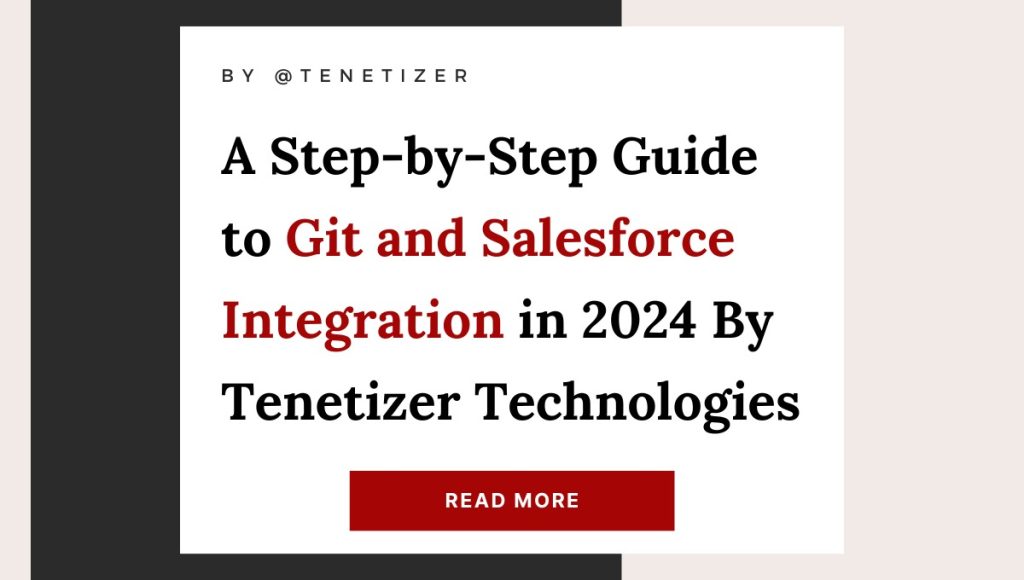Introduction
Many developers encounter challenges when integrating Git with Salesforce, often leading to lost work and confusion. This comprehensive guide aims to provide a step-by-step approach to seamlessly blend Git into Salesforce projects, ensuring smooth, efficient, and error-free development processes.
Understanding Git Basics
4 Key Git Concepts :
Repositories:
Definition: Centralized storage for source code and project files, serving as the single source of truth.
Branches:
Definition: Pointers to specific commits, representing independent lines of development.
Commits:
Definition: Snapshots of code at specific points in time, including a unique identifier.
Pull Requests:
Definition: Platforms for collaboration and proposing changes for merging into the main codebase.
Best Practices for Version Control in Salesforce
Choose the Right Version Control System:
Emphasize Git for its widespread adoption and robust features.
Branching Strategy:
Implement GitFlow or Feature Branching for effective management of development streams.
Isolate development to avoid conflicts and ensure stability.
Use Feature Branching for independent feature development.
Employ Release Branching for controlled testing and finalizing features.
Implement Continuous Integration to merge changes frequently.
Consistent Commit Practices:
Commit changes regularly to track progress.
Use descriptive commit messages to explain changes clearly.
Automate Deployments:
Implement Continuous Integration (CI) with tools like Jenkins, Bamboo, or Salesforce DX.
Validate changes in a test environment before merging.
Handle Conflicts Promptly:
Merge changes frequently to minimize conflicts.
Resolve conflicts promptly to maintain code integrity.
Track and Audit Changes:
Leverage version history for understanding changes and compliance auditing.
Backup and Security:
Regularly back up the version control repository to prevent data loss.
Implement access control for repository security.
Training and Documentation:
Ensure team members are trained in version control systems.
Maintain clear documentation for version control processes.
Review and Refine:
Implement peer reviews for commits to improve code quality.
Regularly review and update version control strategies.
Setting up Git for Salesforce Development
Install Git:
Download and install Git from the official website for your operating system.
Set up Salesforce DX:
Install Salesforce CLI for interacting with Salesforce DX.
Initialize Git:
Use the git init command in your project directory.
Connect to a Remote Repository:
Use git remote add origin <remote_repository_URL> to connect to a remote repository.
Create a Salesforce DX Project:
Use Salesforce CLI to create a new project for local Salesforce development.
Work with Scratch Orgs:
Use Salesforce CLI to create and manage scratch orgs for development and testing.
Create Branches:
Use git branch to create separate branches for features or bug fixes.
Switch to the Branch:
Use git checkout -b to switch to the newly created branch.
Make Changes in Scratch Org:
Use Salesforce CLI and development tools to make necessary changes in the scratch org.
Pull Changes:
Use sf project retrieve start to pull changes made directly in the Salesforce Org.
Push Changes to Git Repository:
Use Git commands to add, commit, and push changes to the corresponding branch.
Merge Changes:
Use Git commands to pull and merge changes from the main branch into feature branches.
Handling Conflicts and Merges
Identify Conflicting Components:
Use Git command line or GUI tools to identify components with conflicting changes.
Understand Changes:
Review conflicting changes made by different developers to understand differences.
Make Necessary Adjustments:
Modify conflicting components to resolve conflicts.
Test Changes:
Thoroughly test merged components for stability and functionality.
Commit and Push Changes:
Commit changes to the branch and push them to the remote repository.
Final Thoughts
Integrating Git with Salesforce can significantly enhance development processes and team collaboration. Features like branches and pull requests facilitate seamless collaboration, while third-party DevOps tools and automation can streamline development and deployment. Leveraging scratch orgs and clicks-based DevOps solutions further accelerates testing and deployment in a production-like environment. Contact us for further implementation.

